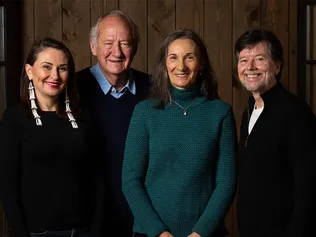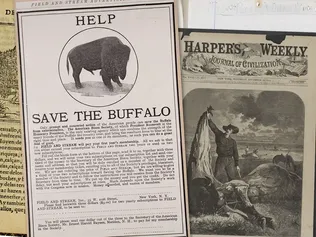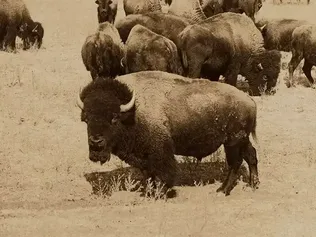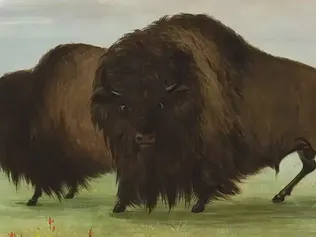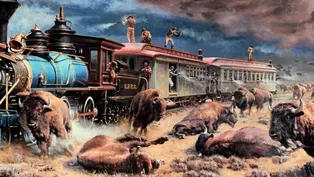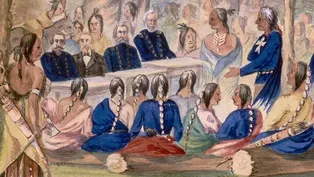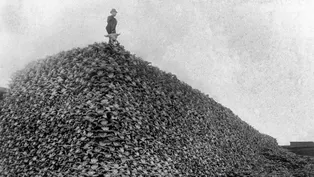
Surprising Facts About the Buffalo
Clip: 10/16/2023 | 9m 40sVideo has Closed Captions
Did you know a buffalo can clear a six-foot fence?
Did you know a buffalo can clear a six-foot fence? Or hit running speeds of 35 miles per hour? These animals may look strange and slow, but they’re "a souped-up hotrod of an animal hiding in a minivan shell." They were also driven nearly to extinction – but that’s only the beginning.
Corporate funding for The American Buffalo was provided by Bank of America. Major funding was provided by the Corporation for Public Broadcasting, and by The Better Angels Society and its...

Surprising Facts About the Buffalo
Clip: 10/16/2023 | 9m 40sVideo has Closed Captions
Did you know a buffalo can clear a six-foot fence? Or hit running speeds of 35 miles per hour? These animals may look strange and slow, but they’re "a souped-up hotrod of an animal hiding in a minivan shell." They were also driven nearly to extinction – but that’s only the beginning.
How to Watch The American Buffalo
The American Buffalo is available to stream on pbs.org and the free PBS App, available on iPhone, Apple TV, Android TV, Android smartphones, Amazon Fire TV, Amazon Fire Tablet, Roku, Samsung Smart TV, and Vizio.
Buy Now
Providing Support for PBS.org
Learn Moreabout PBS online sponsorship♪ Man: They're these big, slightly strange-looking but magnificent, magnificent animals.
And they're ours.
Right?
They're our animal.
Man: If you see one out grazing, it looks so slow.
It's like a parked car sitting there.
But they can clear six-foot fences.
They can jump a horizontal jump of seven feet.
They can hit a speed, hit a speed of 35 miles an hour.
And you're talking about something that can get going that speed that's 1,800 pounds.
It's like a souped-up hot rod of an animal hiding in a minivan shell.
Narrator: Fully grown, an American buffalo can weigh more than a ton, stand taller than six feet at the shoulder, and stretch more than ten feet long, not including the tail.
Huge as they are, they are small compared to some of the prehistoric animals that once roamed the continent: woolly mammoths, giant ground sloths, and camels, and other species of bison, one of which had horns that spanned 9 feet from tip to tip.
After humans arrived in North America more than 20,000 years ago, all of the biggest animals-- along with nearly 50 other species-- went extinct on the continent, from either hunting or changing climate or a combination of the two.
In their place, the modern buffalo evolved and multiplied, particularly on the grasslands of the Great Plains.
Bison and humans, in a real sense, co-evolved alongside one another over the last 10,000 years or so.
Sometimes the animals would ebb and flow, but they always rebounded.
And, so, there was this wonderful kind of dynamic equilibrium that lasted for more than 10,000 years.
Rosalyn Lapier: They have always lived with humans.
They've always been hunted by humans; they've always had predators, so their entire sort of evolution as an animal species has been as an animal that has been hunted.
And their primary defense mechanism is to run away.
And they have that skill at a very young age.
A newborn buffalo calf tries to stand for the first time at the age of two minutes.
And, at seven minutes, they're able to run with the herd.
Narrator: Over the centuries, their grazing habits on the wide expanses of the Great Plains proved crucial to its ecology--the types of grasses that flourished there and the other species that thrived alongside the buffalo.
Even when they stopped and sometimes dug through the grass with their horns and then rolled in the dust, creating "buffalo wallows," the bison's habits helped support other forms of life on the Plains.
Lapier: It's not just one wallow.
We're talking about millions of bison, which means millions of wallows.
Woman: Those wallows could do a couple of things.
At its most simple and basic, it's a "dirt bath."
But then it also has an ecosystem function-- water retention.
If it rained, these become shallow little ponds and pools.
And that, in turn, affected the landscape as well.
Lapier: Because it's also a disturbed area, plants that flourish in disturbed areas will also then grow around a wallow.
So they became these really great areas, not only for wildlife to use but also for humans to use because of the plants that were there.
Woman: When the buffalo are here, the land is good.
When the land is good, the buffalo are healthy.
We have lived here for 600 generations.
We have been here, conservatively, 12,000 years.
So, if you think about that 12,000 years-- imagine that on a timeline, and then take that 12,000 years and wrap that timeline around a 24-hour clock.
What that means is that Columbus arrived at about 11:28 p.m., and Lewis and Clark, at about 15 minutes before midnight.
Narrator: Native Americans seamlessly wove the animals into every aspect of their daily lives and religious beliefs.
N. Scott Momaday: The buffalo was iconic and sacred, and became so deeply ingrained in the life of the tribe that they could not imagine existence without the buffalo.
Narrator: In the ancient origin stories of many tribes, the bison were among the earliest animals created, often emerging before human beings from under ground in what became sacred sites, like Wind Cave in the Black Hills of what is now South Dakota or Oklahoma's Wichita Mountains, whose most prominent peak is now called Mount Scott.
The Kiowas, in particular, believed that this was the mountain from which buffalo had originally emerged and that whenever they went away--and buffalo did go away in the remembered histories of tribal people-- this is where, on the Southern Plains, the buffalo went.
Narrator: The Cheyenne and Lakota each have their own stories about a contest between people and bison to determine which one would have mastery over the other.
In a long and arduous race circling the Black Hills, some of the animals died and stained the soil red forever with their blood.
In the end, the people won.
Man: "The old buffalo bulls called "the young man to come to them.
"'Well, you have won,' they said.
"'You are on top now.
"'All we animals can do is supply the things that "'you will use from us-- our meat and skins and bones.
And we will teach you the Sun Dance.'"
John Stands in Timber.
♪ Narrator: Every tribe on the Plains held ceremonies related to the buffalo, who, it was said, had their own families and clans, their own societies and customs, and were capable of changing forms to communicate directly with humans.
The Mandan, in what is now North Dakota, had the White Buffalo Cow Society-- respected older women, whose leader wrapped herself in the robe of a rare and sacred white buffalo as they danced all night to call the bison herds closer.
In a different ceremony, experienced hunters costumed themselves as buffalo bulls, whose power, called "medicine," could be shared with others in the tribe.
Man: The first thing I was told about buffalo was not really the hunting part of it.
First thing I was told about them was the spirituality part of it, about how they were created by our Creator, how they were put on this earth to help us survive, not only with clothing, with warmth, with food, with tools, but with the essential, which was the spirit of the buffalo, and how the spirit was part of us and we were part of them.
Narrator: Each summer, the Lakota, like many tribes, gathered for a Sun Dance, their most important ceremony, which renewed their relationship with Wakan-Tanka, the great spirit of the universe that permeates everything.
Buffaloes were considered the animal with the most direct connection to that life force.
Over the course of many generations, the Kiowa had moved from the mountains near the headwaters of the Yellowstone River down to the northern Plains; then to the Black Hills; and eventually farther south to the Wichita Mountains in what is now Oklahoma.
Along the way, they learned their Sun Dance from the Crows.
Momaday: The Sun Dance was an indispensable part of the Kiowa life.
And the buffalo was the sacrificial victim of the Sun Dance.
Could not have a Sun Dance without killing a buffalo bull and displaying its head in the Sun Dance lodge.
What more valuable a sacrifice could you make than to kill a buffalo and offer it to the sun?
Woman: You don't just go out and kill a buffalo.
You go to your ceremonies; you pray.
And you ask for the gift of a buffalo.
You ask that a buffalo will give itself to you.
[Native people chant to "Lakota Powwow"] And it's a spiritual relationship.
You do everything in prayer, and you do everything with a pure heart.
Industrial Expansion West and Its Impact
Video has Closed Captions
After the Civil War, Americans set out with renewed energy to unite the East and West. (8m 52s)
Video has Closed Captions
The U.S. government made treaties with Indigenous people when it was convenient. (10m 24s)
Why Is Destruction Part of Our Story?
Video has Closed Captions
The scale of wild animal loss during the 1800s is the largest in known human history. (9m 59s)
Providing Support for PBS.org
Learn Moreabout PBS online sponsorshipCorporate funding for The American Buffalo was provided by Bank of America. Major funding was provided by the Corporation for Public Broadcasting, and by The Better Angels Society and its...

